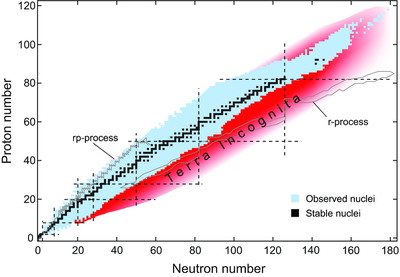
 |
|
| Department of Physics and Astronomy | |

One of the fundamental questions of nuclear structure physics is:
what are the limits of nuclear stability? How many neutrons can we add
to a given nuclear isotope before it becomes unstable against spontaneous
neutron emission (neutron radioactivity)? If one connects the isotopes with zero neutron
separation energy, Sn=0, in the nuclear chart one obtains the
neutron dripline. Similarly, the proton dripline is defined
by the condition Sp=0. There are less than 300 stable nuclear isotopes
to be found in nature (represented by small black dots in figure above). However, an additional 2700
isotopes have been created in experiments, most of these in reactions using low-energy heavy-ion accelerators.
Nuclei in between the proton and neutron driplines are unstable against
beta-decay. Nuclei outside the driplines decay by spontaneous neutron
emission or proton radioactivity.
The neutron-rich side, in particular,
exhibits thousands of nuclear isotopes still to be explored (see "terra
incognita" in figure above). Some of these exotic nuclei can be studied with existing
first-generation Radioactive Ion Beam Facilities. Several countries are constructing new 'second generation' RIB
facilities (RIKEN in Japan, FAIR in Germany, GANIL in France).
In the United States, construction has begun of FRIB (Facility for Rare
Isotope Beams) at Michigan State University.
Another frontier is the production of new superheavy elements in heavy-ion
fusion reactions, in particular around the predicted "island of stability"
with proton numbers Z=114, 120, 126 and neutron number N=184.
Theories predict profound
differences between the known isotopes near stability and the exotic
nuclei at the driplines: for neutron-rich nuclei, as the Fermi level
approaches the particle continuum at E=0, weakly bound neutron states
couple strongly to the continuum giving rise to neutron halos and
neutron skins. Theories also expect large pairing correlations and new
types of collective modes, a weakening of the
spin-orbit force leading to a quenching of the shell gaps, and perhaps
new magic numbers.
Furthermore, Radioactive Ion Beam Facilities will allow us to address
fundamental questions in nuclear astrophysics: more than half of all
elements heavier than iron are thought to be produced in
supernovae explosions by the rapid neutron capture process (r-process).
The r-process path contains many exotic neutron-rich nuclei which can
only be studied with these new heavy-ion accelerators.
Class meetings: Tuesday and Thursday, 09:30 am, SC 6614
Office hours: Most of the time, you will find me in my office. Please
feel free to drop by my office whenever you have any questions, and I
will try to accomodate you if possible.
Instructor: Professor Sait Umar
Phone: 615-322-5035
Office: Stevenson Center, 6th floor, room 6626
e-mail: sait.a.umar@vanderbilt.edu
Basic experimental facts and phenomenological models (shell model and collective model). Nucleon-nucleon interaction, mean-field theories of nuclear structure (Hartree-Fock, BCS pairing, HFB, RPA and QRPA). Ab-initio calculations for light nuclei. Time-dependent Hartree-Fock calculations of heavy-ion reactions. Prerequisite: PHYS 8030. [3]
The aim of theoretical nuclear physics is to
study the quantum many-particle aspects of two of nature's four fundamental
forces: the strong and the weak interaction. Depending upon the relative
energy of the nuclear constituents, very different theoretical descriptions
are needed:
Low-energy nuclear structure
and reaction phenomena are described in terms of protons and neutrons
which interact via a nucleon-nucleon potential that depends on
the positions, momenta, spins and isospins of the nucleons. For relatively
light nuclei, non-relativistic "ab-initio" calculations are possible, but heavier systems
require a mean-field approximation.
Alternatively, relativistic mean-field theories have been developed in
which pointlike nucleons are described by the Dirac equation,
interacting via classical meson fields.
In the medium-energy
regime, particle creation and annihilation becomes a dominant feature;
also, it is no longer sufficient to consider just the nucleons
themselves, but other low-lying baryonic resonances and light mesons
must be taken into account. The appropriate theoretical framework is
the quantum theory of interacting baryon and meson fields.
At relativistic energies,
the quark substructure of the baryons and mesons comes into play, and the
proper starting point of the theory is the Lagrangian of Quantum
Chromodynamics (QCD).
Almost all interacting quantum many-particle systems cannot be adequately
described by perturbation theory, a powerful tool which governs
most of elementary particle physics. In fact, the interesting physical
observables (e.g. the Hartree-Fock or BCS ground state energy of the
many-body quantum system) are equivalent to an infinite sum of
perturbative diagrams! This requires the development of new
many-body approximation schemes.
Because of the mathematical complexity of the quantum many-body equations,
a numerical implementation on
scientific workstations and supercomputers becomes necessary.
I will not use any particular textbook.
Rather, the lecture material will be drawn from a variety of textbooks
and review articles (see the "Bibliography" section of this Website for
details).
All lecture notes and PowerPoint presentations will be posted (in PDF format)
in the "Lecture materials" section of the Website.
Phys 8140 Website: http://compsci.cas.vanderbilt.edu/~umar/p8140/
Quantum Mechanics 8030.